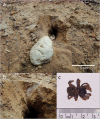Digging up food: excavation stone tool use by wild capuchin monkeys
- PMID: 28740211
- PMCID: PMC5524703
- DOI: 10.1038/s41598-017-06541-0
Digging up food: excavation stone tool use by wild capuchin monkeys
Abstract
Capuchin monkeys at Serra da Capivara National Park (SCNP) usually forage on the ground for roots and fossorial arthropods, digging primarily with their hands but also using stone tools to loosen the soil and aid the digging process. Here we describe the stone tools used for digging by two groups of capuchins on SCNP. Both groups used tools while digging three main food resources: Thiloa glaucocarpa tubers, Ocotea sp roots, and trapdoor spiders. One explanation for the occurrence of tool use in primates is the "necessity hypothesis", which states that the main function of tool use is to obtain fallback food. We tested for this, but only found a positive correlation between plant food availability and the frequency of stone tools' use. Thus, our data do not support the fallback food hypothesis for the use of tools to access burrowed resources.
Conflict of interest statement
The authors declare that they have no competing interests.
Figures







Similar articles
-
The enhanced tool-kit of two groups of wild bearded capuchin monkeys in the Caatinga: tool making, associative use, and secondary tools.Am J Primatol. 2009 Mar;71(3):242-51. doi: 10.1002/ajp.20642. Am J Primatol. 2009. PMID: 19051323
-
Sexual bias in probe tool manufacture and use by wild bearded capuchin monkeys.Behav Processes. 2014 Oct;108:117-22. doi: 10.1016/j.beproc.2014.09.036. Epub 2014 Oct 19. Behav Processes. 2014. PMID: 25446625
-
Wild capuchin monkeys adjust stone tools according to changing nut properties.Sci Rep. 2016 Sep 14;6:33089. doi: 10.1038/srep33089. Sci Rep. 2016. PMID: 27624672 Free PMC article.
-
Animal behavior: the right tool for the job.Curr Biol. 2009 Feb 10;19(3):R124-5. doi: 10.1016/j.cub.2008.12.001. Curr Biol. 2009. PMID: 19211051 Review.
-
Anointing variation across wild capuchin populations: a review of material preferences, bout frequency and anointing sociality in Cebus and Sapajus.Am J Primatol. 2012 Apr;74(4):299-314. doi: 10.1002/ajp.20971. Epub 2011 Jul 18. Am J Primatol. 2012. PMID: 21769906 Review.
Cited by
-
Characterization of Stone Tool Use in Wild Groups of Critically Endangered Yellow-Breasted Capuchin Monkeys (Sapajus xanthosternos).Am J Biol Anthropol. 2025 Feb;186(2):e70002. doi: 10.1002/ajpa.70002. Am J Biol Anthropol. 2025. PMID: 39981595 Free PMC article.
-
A new addition to the toolbox: stone tool use in blonde capuchin monkeys (Sapajus flavius).Primates. 2024 Sep;65(5):383-389. doi: 10.1007/s10329-024-01143-7. Epub 2024 Jun 27. Primates. 2024. PMID: 38935179
-
Earliest evidence of primate captivity and translocation supports gift diplomacy between Teotihuacan and the Maya.Proc Natl Acad Sci U S A. 2022 Nov 22;119(47):e2212431119. doi: 10.1073/pnas.2212431119. Epub 2022 Nov 21. Proc Natl Acad Sci U S A. 2022. PMID: 36399550 Free PMC article.
-
Habitual stone-tool-aided extractive foraging in white-faced capuchins, Cebus capucinus.R Soc Open Sci. 2018 Aug 22;5(8):181002. doi: 10.1098/rsos.181002. eCollection 2018 Aug. R Soc Open Sci. 2018. PMID: 30225086 Free PMC article.
-
Insights into the evolutionary history of the most skilled tool-handling platyrrhini monkey: Sapajus libidinosus from the Serra da Capivara National Park.Genet Mol Biol. 2023 Nov 10;46(3 Suppl 1):e20230165. doi: 10.1590/1678-4685-GMB-2023-0165. eCollection 2023. Genet Mol Biol. 2023. PMID: 37948505 Free PMC article.
References
-
- Falótico T, Ottoni EB. The manifold use of pounding stone tools by wild capuchin monkeys of Serra da Capivara National Park, Brazil. Behaviour. 2016;153:421–442. doi: 10.1163/1568539X-00003357. - DOI
-
- Izawa K. Foods and feeding behavior of wild black-capped capuchin (Cebus apella) Primates. 1979;20:57–76. doi: 10.1007/BF02373828. - DOI
Publication types
MeSH terms
LinkOut - more resources
Full Text Sources
Other Literature Sources

